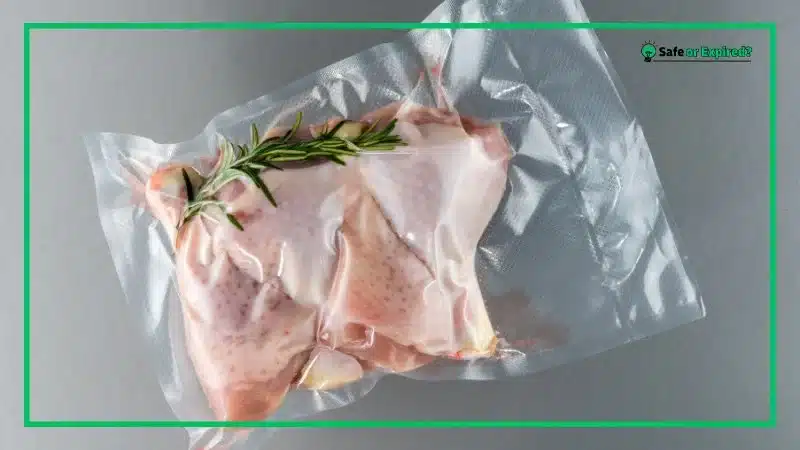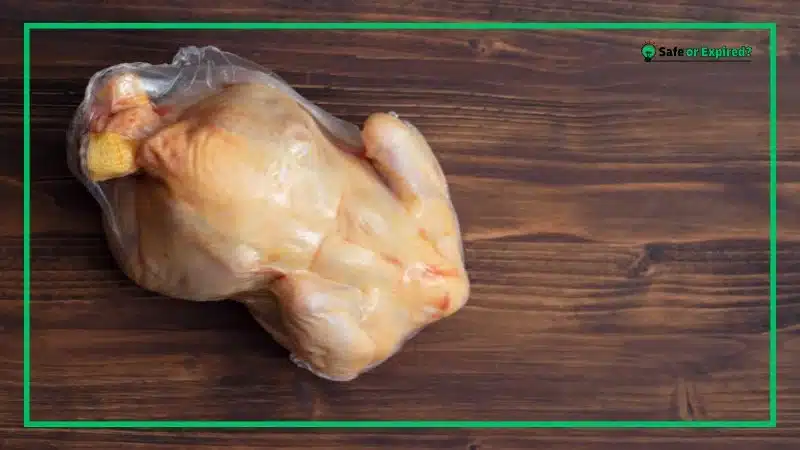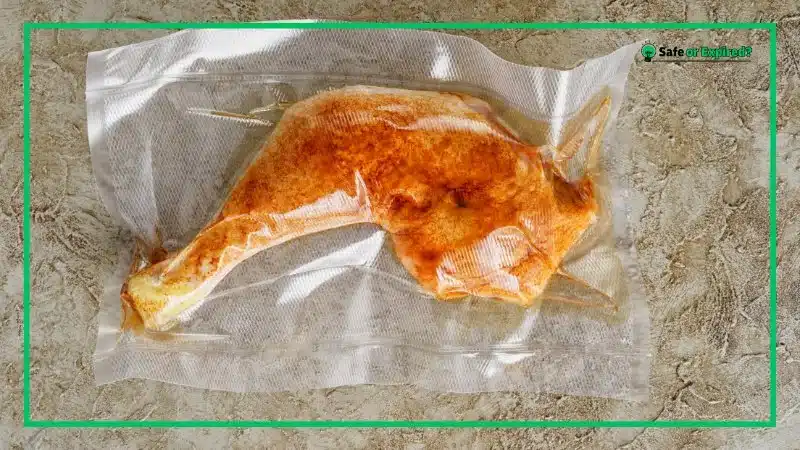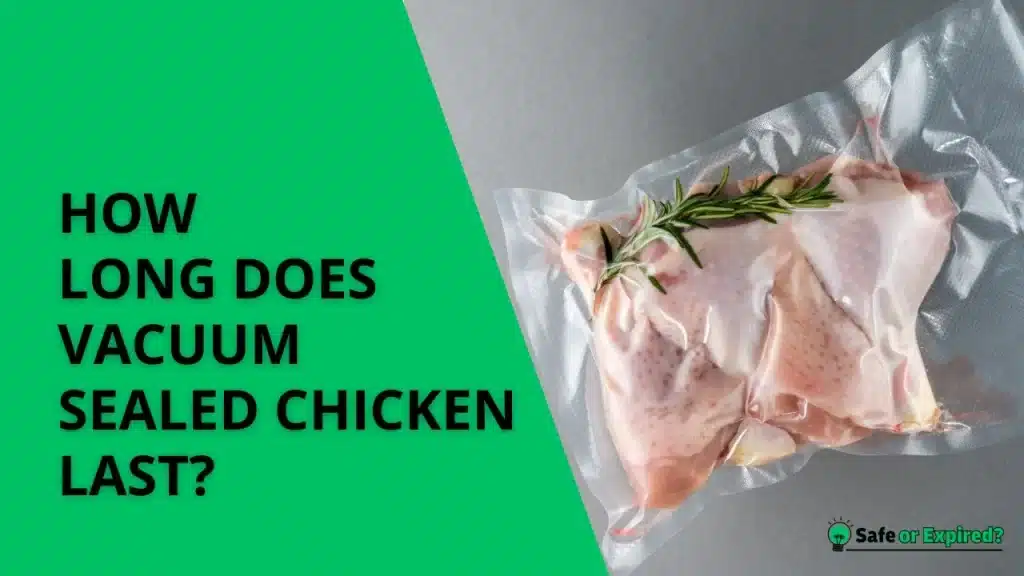“How long does vacuum sealed chicken last?” is a question many of us ask as we try to make our groceries last longer and reduce waste. Well, note that it can last from hours to months (depending on the storage).
Whether you’re storing it in the fridge, freezer, or room temperature, I’ve got all the answers. Continue reading to find out the top tips for keeping your chicken fresh and tasty for as long as possible!
How Long Does Vacuum Sealed Chicken Last?
Vacuum-sealed chicken can last significantly longer than chicken stored using traditional methods because it reduces air exposure, which slows down spoilage and bacterial growth. Generally, it can stay good for hours to months, depending on where you store it.
Let’s discuss one by one.
How Long Does Vacuum Sealed Food Last at Room Temperature? (Find Out)
Vacuum-sealed food should not be stored at room temperature for more than a few hours. This is because perishable foods like chicken can develop bacteria rapidly at room temperatures between 40°F and 140°F. Always refrigerate or freeze vacuum-sealed food for long-term storage.

How Long Does Vacuum-Packed Chicken Last in the Fridge?
Vacuum-packed chicken can last in the fridge for up to 1-2 weeks. This is much longer than regular chicken (not vacuum sealed), which typically lasts about 1-2 days in the fridge. The airtight seal prevents bacteria from entering and spoiling the meat.
How Long Does Vacuum-Packed Chicken Last in the Freezer?
When vacuum-packed and frozen, chicken can last for up to 2-3 years without significant loss in quality. The vacuum seal prevents freezer burn and protects the chicken’s texture and flavor during long-term storage. So, expect vacuum-sealed chicken in the freezer to stay good for a long time.
Freezing is a highly effective method for preserving the freshness of various foods, including chicken. The low temperatures halt the growth of bacteria and slow down enzymatic processes that cause food to spoil.
How Long Does Vacuum Sealed Chicken Last After Sell-By Date?
Vacuum sealed chicken can typically last 1-2 weeks beyond the sell-by date if kept refrigerated. The vacuum seal keeps the chicken fresher longer by preventing exposure to air, which encourages bacterial growth. Always check for freshness before use.
How Long Does Costco Vacuum Sealed Chicken Last?
Costco’s vacuum-sealed chicken, if kept refrigerated, is safe to consume for up to 1-2 weeks past the printed sell-by date. This extended shelf life is due to the efficient vacuum sealing process used, which significantly reduces air exposure and bacterial growth.

How Long Does Vacuum Sealed Chicken Breast Last in the Freezer?
Vacuum sealed chicken breast can be stored safely in the freezer for up to 2 years. This method of storage prevents freezer burn and preserves the quality of the chicken, maintaining its texture, flavor, and nutritional value over a long period.
How Long Does Thawed Vacuum Sealed Chicken Last in the Fridge?
Once thawed, vacuum-sealed chicken should be used within 3-4 days if kept refrigerated. It’s important not to leave thawed chicken at room temperature for more than 2 hours to avoid bacterial growth. Always thaw in the fridge or use cold water for safety.
Here’s a table that outlines the shelf life of vacuum-sealed chicken in various storage situations:
| Storage Situation | Shelf Life |
| Room Temperature | Up to 2 hours |
| Refrigerator | 1-2 weeks |
| Freezer | Up to 2 years |
| After Sell By Date (if fresh) | 1-2 weeks in fridge |
| After Thawing in Fridge | 3-4 days |
How To Know Vacuum Sealed Chicken Has Gone Bad?
To determine if vacuum-sealed chicken has gone bad, look for spoilage signs, like changes in color, smell, and texture. Spoiled chicken will often have a sour or unpleasant odor and a slimy texture, and it may display a dull color or grayish spots. These signs indicate that the chicken is no longer safe to eat.
Changes in Smell
If your vacuum-sealed chicken starts to smell sour, strong, or just plain bad, it’s a clear sign that it has gone bad. Fresh chicken should have a very mild scent, so any strong odors mean that bacteria have started to grow, making the chicken unsafe for eating. Always trust your nose—if something smells off, it’s better to be safe and throw it away.
Changes in Color
Fresh vacuum sealed chicken should have a light pink hue with white fat. If you notice that the chicken has turned dull, grey, or has spots of green or gray, it’s likely spoiled. These color changes can happen even if the chicken is sealed, indicating that the meat has begun to degrade and should not be consumed.
Changes in Texture
Feel the surface of the chicken through the packaging. If it feels slimy or sticky, the chicken has likely gone bad. Fresh chicken should feel firm and dry. Once bacteria sets in, it produces a slimy film that covers the chicken’s surface. If you detect this texture, it’s best to discard the chicken to avoid any health risks.
What to Do With Expired Vacuum Sealed Chicken?
If you discover expired vacuum-sealed chicken, it’s safest to discard it to avoid foodborne illness. However, if the chicken still smells, looks, and feels fresh despite the expired date, you may consider using it immediately after cooking thoroughly to a safe temperature.
Discard If Doubtful
When in doubt, throw it out! If your vacuum-sealed chicken has expired and you’re unsure about its freshness, it’s best to discard it. Consuming expired vacuum sealed chicken can lead to food poisoning, which is not worth the risk. It’s essential to prioritize health and safety over saving food.
Cook Thoroughly If Still Fresh
If the expired chicken shows no signs of spoilage—no bad smells, discoloration, or slimy texture—you might choose to use it. In this case, ensure it is cooked thoroughly. I suggest the internal temperature to be 165°F (74°C) to kill bacteria.
Cooking thoroughly can make it safe to eat, but always use your best judgment based on the chicken’s appearance and smell.
Use in Composting
If you decide not to eat the chicken, consider composting it if you have the facilities. Chicken is great for compost heap as it introduces nitrogen — a crucial element for compost. However, make sure it’s buried deep within your compost to prevent attracting animals and to help it break down effectively.
How to Keep Vacuum Sealed Chicken Fresh for Longer?
To keep vacuum-sealed chicken fresh for longer, store it in the coldest part of your refrigerator or freezer immediately after purchase. Ensure the seal is tight, and always check the temperature settings to maintain optimal freshness.
Store in the Coldest Part of the Refrigerator
Place your vacuum-sealed chicken in the coldest part of the refrigerator, usually the bottom shelf or a specific meat drawer. This area is less affected by temperature changes from opening the door and maintains a more consistent cool temperature, which is crucial for keeping the chicken fresh.
Check the Seal
Before storing, ensure that the vacuum seal is tight and intact with no tears or leaks. A proper seal prevents air and bacteria from entering the package, which are the primary causes of spoilage. If the seal is broken, consider using the chicken immediately or resealing it if possible.

Monitor Refrigerator Temperature
It’s recommended to keep your refrigerator temperature at or below 40°F (4°C). This temperature range slows down bacterial growth significantly, extending the freshness of your vacuum sealed chicken. Regularly check your fridge’s temperature settings and adjust them if necessary to ensure it’s always at the ideal temperature.
Freeze for Long-Term Storage
For long-term storage, you should go for freezing. Vacuum-sealed chicken can be stored in the freezer for up to two years without significant quality loss. When freezing, place the chicken in the back of the freezer where the temperature is most stable, avoiding the door area where temperature fluctuations are more common.
Label and Date the Packages
Always label your vacuum-sealed chicken with the date of purchase and the date it was sealed if repackaging at home. This helps you track how long the chicken has been stored and ensures you use it within its optimal freshness period. Keeping a record can prevent you from guessing and potentially using chicken that’s past its best quality.
Avoid Frequent Temperature Changes
Try to minimize the number of times you take the chicken out of the fridge or freezer. Frequent temperature changes can cause condensation inside the packaging, which might compromise the chicken’s quality and safety.
Plan your meals ahead so you can defrost or refrigerate the chicken properly without exposing it to temperature swings.
Use a Dedicated Storage Area
If possible, dedicate a specific area of your refrigerator or freezer for meats like chicken. This practice helps in preventing cross-contamination with other foods and maintains better organization in your kitchen.
Having a dedicated meat storage area also ensures that all meats are stored correctly and accessed easily without disturbing other food items.
All in all, how you store food can make a big difference. Get practical tips in “Simple Food Storage and Preservation Tips.”
Thaw Safely
When you’re ready to use frozen vacuum sealed chicken, thaw it safely to maintain its quality. The best method is to thaw it in the refrigerator, which keeps the chicken at a safe temperature during the thawing process.
Avoid thawing chicken at room temperature on the counter, as this can encourage bacterial growth. That’s all.
Conclusion
Vacuum sealing is a powerful technique to extend the shelf life of chicken, but knowing the right storage practices is key. Here’s a quick recap:
- Vacuum-sealed chicken lasts 1-2 weeks in the fridge and up to 2-3 years in the freezer when properly stored.
- Always store at or below 40°F in the refrigerator or at stable freezing temperatures to maintain quality.
- Inspect the seal regularly to ensure it is airtight and intact, as any leaks can lead to spoilage.
- Follow safe thawing practices, such as thawing in the refrigerator, to maintain the chicken’s quality and safety.
Now, you can enjoy delicious, fresh chicken for longer periods, making the most of your meals and budget.

